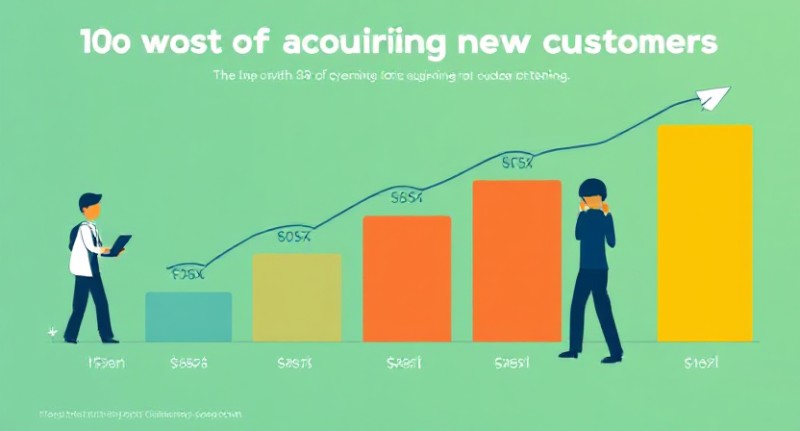The process of launching a new company is thrilling and full of expectation. Knowing how successfully your company plans are performing, however, is essential. Growth metrics can help with it. These quantifiable figures demonstrate the effectiveness and expansion of your company. Startup growth metrics to track examining these figures may be daunting and complicated, despite their significance. It might be difficult to determine which indicators are actually essential when there are so many to take into account. The significance of this endeavor is shown by the many businesses that began with great expectations but failed to meet their objectives.
We've carefully developed a list of the 11 most crucial growth measures to assist you in navigating this tricky terrain. These are the main metrics that provide a comprehensive picture of the development of your company. When evaluating an investment, these are the measures that prospective investors find most useful. With this information in your toolbox, you'll be more equipped to steer your company toward success despite any obstacles you may encounter.
How is the growth of a startup measured?
For entrepreneurs, growth metrics are crucial tools. They offer a strong basis for tracking the expansion and development of your company. Consider it as monitoring the performance and expansion of your business. With the help of these measures, you can clearly see where your company is now and where it is going. Why take growth measurements? In other words, you cannot manage what you cannot quantify.
You must be aware of which areas of your business are doing well and which require development if you want to make sure it is on a growth trajectory. Key Performance Indicators (KPIs) are frequently used in this situation. KPIs are certain measurements that companies use to assess how well they are doing in achieving particular objectives. Perhaps you might think about growth planning as an alternative method of monitoring the progress of your company.
This entails employing measurements to inform strategic choices that support the expansion of your company. Keep in mind that there isn't a single solution that works for everyone. Your sector and business objectives will have a big impact on the metrics you use.
You should be aware of certain growth measures regardless of the strategy you choose. Knowing these indicators can help you make better business decisions, even if you don't monitor them all. Every indicator, from monthly active users to client acquisition expenses, has the power to propel growth and influence your startup's course.
Top 12 Startup Growth Metrics To Track
1. The cost of acquiring new customers

One important indicator that measures the resources used to acquire a new client is the Customer Acquisition Cost (CAC). This covers all of the expenses related to sales, marketing, and advertising.
The entire amount spent on these initiatives is divided by the number of clients attracted in the same period of time to determine CAC. Effective expenditure is indicated by a lower CAC; however, a growing CAC can call for a review of your acquisition tactics.
Read also: Most Popular Programming Languages 2024
2. Rate of churn (Startup Growth Metrics To Track)
The rate at which clients discontinue doing business with you over a specific time frame is known as the churn rate. A high turnover rate may indicate problems with consumer happiness, the quality of the product, or the provision of services. To calculate your churn rate, divide the number of lost customers by the total at the beginning of the quarter.
3. Lifetime Value of Customers
One important statistic that estimates the entire income a company may realistically anticipate from a single customer account is Customer Lifetime Value (CLV). It takes into account the revenue worth of a client and contrasts it with the anticipated customer longevity of the business.
Companies utilize this statistic to determine which important client groups yield the most profits over an extended period of time. The average purchase value, average buy frequency rate, and average client lifespan are multiplied to determine CLV.
4. The typical order size (Startup Growth Metrics To Track)
Your clients' normal purchasing habits may be inferred from the average order size. By dividing your total sales by the quantity of orders placed, you may determine it. Greater numbers imply that buyers are prepared to pay more for each purchase, which may indicate buyer confidence and the worth of the goods.
5. Annual Run Rate (ARR) and Monthly Recurring Revenue (MRR)
One of the most important metrics for firms using a subscription model is Monthly Recurring Revenue (MRR). MRR provides a comprehensive snapshot of your monthly subscription income stream. Your MRR is equivalent to the entire monthly subscription income.
The Annual Run Rate (ARR) is comparable to MRR but spread out across a year. Multiply your MRR by 12 to determine your ARR. If present patterns continue, this statistic provides a quick and simple approach to forecast future revenue.
6. Burn rate and cash runway
The amount of time your startup can continue to function on its current financial reserves is known as the cash runway. Our next crucial measure is determined by dividing your present cash balance by your monthly burn rate.
The rate at which your startup's financial reserves are being depleted each month is known as the burn rate. It's critical to keep an eye on your burn rate in order to preserve your financial security and prevent running out of money too soon.
Read also: Startup Growth Strategies: A Comprehensive Guide
7. Sources of Traffic and Referrals (Startup Growth Metrics To Track)
Finding the channels that work best for your company requires knowing where your consumer traffic and referrals come from. Below is a summary of a few popular techniques:
•Word of Mouth: When pleased clients individually refer your company to others they know, this natural marketing strategy takes place. Significant growth may be achieved with a strong word-of-mouth presence without a large marketing budget.
• Direct Referrals: These originate from a particular alliance or connection with another organization. For example, if another company believes in your service, they could recommend your startup to their clients. By keeping track of these recommendations, you might find worthwhile connections to cultivate.
• Digital advertisements: For many companies, online advertising—from banner advertisements on websites to search engine ads—is a crucial source of traffic. You may evaluate the efficacy and return on investment of your digital advertisements by tracking the traffic and conversion rates.
• Organic: Visitors that discover your company through unpaid search results are referred to as organic traffic. Strong SEO success is frequently indicated by high organic traffic, which shows that your startup is visible and appealing to online prospects.
• Social: Your social media accounts are the source of social traffic. Monitoring this indicator gives you insight into how well your social media marketing tactics draw in and interact with consumers.
Every one of these traffic sources has the capacity to greatly advance your development. You may have a better understanding of where to devote resources for optimal impact by keeping an eye on each one separately.
8. Gross Margin and Sales
The entire income from all sales transactions over a certain time period, before expenses are deducted, is known as gross sales. This raw number provides a general idea of the size and sales performance of your company. Furthermore, profitability is gauged by the gross margin.
The computation involves taking the whole revenue and deducting the cost of goods sold (COGS). The result is then divided by the total revenue. This percentage indicates the amount of money left over after direct expenses.
While a low gross margin may indicate inefficiencies and necessitate a reassessment of pricing or production, a high one indicates effective production and competitive pricing. When combined, these KPIs provide you a quick overview of the financial health of your firm.
Read also: The Top 5 Fintech Innovators Making Waves in 2024
9. Profit and Cash Flow (Startup Growth Metrics To Track)
Since they provide information about your company's liquidity and earning potential, cash flow and profit are two essential financial indicators that new businesses need to keep an eye on. The flow of money into and out of your company is reflected in your cash flow. Maintaining your startup's daily operations and overall financial stability depends on having a positive cash flow.
It guarantees that you have enough cash on hand to pay for running costs like rent and wages while still having room to invest in expansion prospects. Conversely, profit is the amount of money left over after all costs have been subtracted from revenue. It's an obvious sign of how much money your business can make.
Profit serves as both a source of cash that can be put in the company to support expansion and a means of survival. The goal is to balance these two measures. Profit demonstrates your ability to make money, but cash flow maintains your company's viability and enables you to take advantage of new growth prospects. By keeping an eye on both, you may create a firm that is both financially stable and focused on expansion.
10. Active Users per Month (MAU)
Monitoring your Monthly Active Users (MAU) is crucial if your firm uses a digital platform, such as an app or website. It gives you information about user engagement and platform growth by showing how many distinct people connect with your platform each month.
11. NPS, or net promoter score
One important indicator for assessing customer happiness and loyalty is the Net Promoter Score (NPS). Customers are asked: How likely are you to tell a friend or coworker about our product? A high NPS indicates that your product is valued by clients and that it meets market demands well.
NPS may provide insight into your product-market fit even if it is a stand-alone indicator. Product-market fit is further shown by other measures, such as total revenue and client acquisition rates. Monitoring these in addition to NPS may help you make strategic choices and make sure your product meets consumer needs.
12. Retention Rate (Startup Growth Metrics To Track)
Don't become fixated on merely gaining additional clients. Maintaining your current clientele is crucial; if you don't, they will soon feel neglected and abandoned and will most likely go elsewhere.
Consider your cost of acquisition (CAC) and the expense of neglecting a current client in order to spend more money on acquiring a new one. Doesn't it sound like a profitable venture? Approximately 44% of businesses, according to Invesp, place more emphasis on gaining new clients than on keeping existing ones (18%).
For your company model, which startup metrics should you monitor?
The indicators you should monitor for startup growth are mostly determined by your goals and company plan. If your firm is subscription-based, you should keep an eye on MRR and ARR. Monitoring MAUs will be helpful if your company operates online, as through an app.
To maintain financial stability, all companies, regardless of their company strategy, should pay close attention to their cash runway and burn rate. Take into consideration your present business needs and emphasis when choosing which indicators to emphasize. Do you want to expand your clientele?
Then closely monitor CAC. Do you want to learn more about your customers? Aim for product-market fit and think about monitoring NPS. Keep in mind that these measures are not a goal in themselves. These are tools that should help you improve your company's operations and spur development. Finding a platform that makes it simple to monitor the KPIs of your company might be helpful if you need further assistance.
Making use of data to direct your startup process
It may be like navigating a huge, unknown ocean when you are running a business. It's thrilling, intimidating, and unpredictable. Growth measurements, on the other hand, may act as your compass, helping you navigate the highs and lows of your entrepreneurial path. They help you make strategic decisions, recognize your strengths, and target areas that need development.
A clear vision, an inspired workforce, and a product or service that meets a real market demand should all be prioritized over these indicators, even if they are an essential part of corporate management.
Therefore, think of these KPIs as your guides as you set out on your company journey. Don't lose sight of your vision; stay committed to your objective; and stay focused on your consumers. You can make sure your startup is moving in the correct way and put yourself on track for success in your business ventures by routinely monitoring your growth KPIs.
Conclusion on Startup Growth Metrics To Track
Any startup that wants to succeed and scale must monitor the appropriate growth KPIs. Startups may learn a lot about their performance and opportunities for development by concentrating on important indicators such as user engagement, monthly recurring revenue (MRR), churn rate, lifetime value (LTV), and customer acquisition cost (CAC). These indicators show investors the potential of your business and assist you in making well-informed decisions. Keep in mind that growth is about more than simply statistics; it's about making sustainable progress and providing value to your clients. For long-term success, keep an eye on things, adjust as needed, and strategically expand!
FAQs: Startup Growth Metrics to Track
How to measure startup growth?
-
Customer Acquisition Cost (CAC)
-
Churn rate.
-
Customer Lifetime Value.
-
Average order size.
-
Monthly Recurring Revenue (MRR) and Annual Run Rate (ARR)
-
Cash runway and burn rate.
-
Referrals and Traffic Sources.
-
Gross Sales and Gross Margin.
What is KPI in a startup? (Startup Growth Metrics To Track)
Businesses may utilize key performance indicators to gauge their progress and identify areas where their operations need to be improved. Key performance indicators may assist new businesses in building their brand, growing sales, and maintaining their financial stability.
What are startup metrics?
Basically, startup metrics are real exams that assist you in knowing the operation, expansion, and general success of your business. These indicators offer insightful information on a number of business-related topics, including revenue generation, customer engagement, user acquisition, and operational efficiency.
What is a good CAGR for a startup? (Startup Growth Metrics To Track)
How Does a Good CAGR Look? A 5% to 12% CAGR in revenue is appropriate for businesses with a lot of cash. A 15%–30% CAGR is ideal for small- and mid-cap businesses. Conversely, startup businesses have to have a CAGR between 100% and 500%.
What is GMV vs. topline? (Startup Growth Metrics To Track)
The value of all merchandise transactions completed by your website over a certain time period is represented as GMV, or gross merchandise value. GMV does not take fees, refunds, or discounts into account like revenue does. GMV displays your company's gross sales performance from a top-line standpoint.



.webp)



